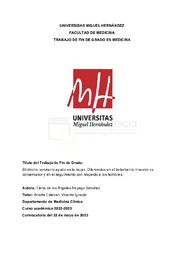Please use this identifier to cite or link to this item:
https://hdl.handle.net/11000/33904Full metadata record
| DC Field | Value | Language |
|---|---|---|
| dc.contributor.advisor | Arrarte Esteban, Vicente Ignacio | - |
| dc.contributor.author | Rayego Sánchez, Elena de Los Ángeles | - |
| dc.contributor.other | Departamentos de la UMH::Medicina Clínica | es_ES |
| dc.date.accessioned | 2024-11-18T12:07:32Z | - |
| dc.date.available | 2024-11-18T12:07:32Z | - |
| dc.date.created | 2024-05-12 | - |
| dc.identifier.uri | https://hdl.handle.net/11000/33904 | - |
| dc.description.abstract | Introducción: El síndrome coronario agudo con elevación del ST (SCACEST) supone una pérdida de la perfusión de las arterias coronarias que se objetiva en el ECG. Su reperfusión mediante angioplastia primaria debe realizarse antes de dos horas. Su clínica en las mujeres se acompaña de más síntomas. La prevalencia de sus causas y sus criterios electrocardiográficos varían en función del género. Objetivos: Determinar las diferencias de género en los tratamientos y el seguimiento del SCACEST Material y métodos: Se ha realizado una revisión bibliográfica para recopilar datos sobre los tratamientos invasivo vs conservador y el seguimiento del SCACEST en hombres y mujeres. Se utilizó la base de datos de Pubmed empleando como palabras clave “STEMI” y “WOMEN” en una primera búsqueda, y añadiendo “CARDIAC REHABILITATION” en la segunda. Entre ambas se seleccionaron 17 artículos. Resultados: La mortalidad cardiovascular intrahospitalaria y/o al año de la PCI resultó mayor en mujeres para tres estudios, y no resulto significativa para uno. Se observaron más eventos adversos intrahospitalarios o al año en mujeres para dos estudios, mientras que uno no fue significativo. En el tratamiento médico los anticoagulantes, antiagregantes y estatinas analizadas presentaban eficacia en ambos géneros. No se redujo la mortalidad total o accidente cerebrovascular en mujeres en las estatinas y clopidogrel, aunque sí el riesgo cardiovascular. Respecto a la rehabilitación cardiaca, la derivación por género parece similar según el porcentaje una vez ajustada a su respectiva población, en tres de cuatro estudios. Conclusiones: Las diferencias de género obtenidas se podrían explicar por las características de la población, donde las mujeres son mayores y presentan más comorbilidades. O por la cantidad de la muestra, donde la representación femenina siempre es menor. En algunos estudios también se dan causas desconocidas y en otros no se confirman diferencias. No se puede concluir con evidencia de diferencias en el tratamiento y seguimiento de las mujeres respecto a los hombres. Se necesitaría más investigación donde la población y la muestra sean más equitativas. | es_ES |
| dc.description.abstract | Introduction: Acute coronary syndrome with ST elevation (STEMI) involves a loss of perfusion of the coronary arteries that is observed on the ECG. Its reperfusion through primary angioplasty must be performed within two hours. Its symptoms in women are accompanied by more symptoms. The prevalence of its causes and its electrocardiographic criteria vary depending on gender. Objectives: Determine gender differences in the treatments and follow-up of STEMI Material and methods: A bibliographic review has been carried out to collect data on invasive vs conservative treatments and follow-up of STEMI in men and women. The Pubmed database was used using “STEMI” and “WOMEN” as keywords in the first search, and adding “CARDIAC REHABILITATION” in the second. Between them, 17 articles were selected. Results: In-hospital and/or one-year cardiovascular mortality after PCI was higher in women for three studies and was not significant for one. More in-hospital or 1-year adverse events were observed in women for two studies, while one was not significant. In medical treatment, the anticoagulants, antiplatelets and statins analyzed were effective in both genders. Total mortality or stroke in women was not reduced by statins and clopidogrel, although cardiovascular risk was. Regarding cardiac rehabilitation, the referral by gender seems similar according to the percentage once adjusted to their respective population, in three of four studies. Conclusions: The gender differences obtained could be explained by the characteristics of the population, where women are older and have more comorbidities. Or because of the size of the sample, where female representation is always lower. In some studies, unknown causes are also given and in others no differences are confirmed. It cannot be concluded with evidence of differences in the treatment and follow-up of women compared to men. More research would be needed where the population and sample are more equitable. | es_ES |
| dc.format | application/pdf | es_ES |
| dc.format.extent | 35 | es_ES |
| dc.language.iso | spa | es_ES |
| dc.publisher | Universidad Miguel Hernández | es_ES |
| dc.rights | info:eu-repo/semantics/openAccess | es_ES |
| dc.rights | Attribution-NonCommercial-NoDerivatives 4.0 Internacional | * |
| dc.rights.uri | http://creativecommons.org/licenses/by-nc-nd/4.0/ | * |
| dc.subject | SCACEST | es_ES |
| dc.subject | mujer | es_ES |
| dc.subject | rehabilitación cardiaca | es_ES |
| dc.subject.other | CDU::6 - Ciencias aplicadas::61 - Medicina | es_ES |
| dc.title | Síndrome coronario agudo en la mujer. Diferencias en el tratamiento invasivo vs conservador y en el seguimiento con respecto a los hombres. | es_ES |
| dc.type | info:eu-repo/semantics/bachelorThesis | es_ES |

View/Open:
RAYEGO SÁNCHEZ, ELENA DE LOS ÁNGELES, TFG.pdf
1,21 MB
Adobe PDF
Share:
.png)
